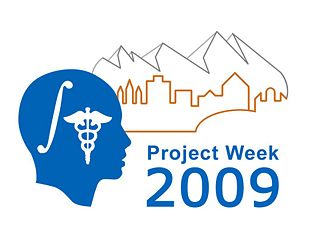Difference between revisions of "Two-tensor tractography in Slicer using Python and Teem"
| Line 18: | Line 18: | ||
<h1>Objective</h1> | <h1>Objective</h1> | ||
| − | Our objective is to finalize the integration of the Two-Tensor Streamline Tractography method into Slicer and to test it on diverse DWI datasets. Furthermore the optimal parameter settings to run the algorithm needs to be investigated. | + | Our objective is to finalize the integration of the Two-Tensor Streamline Tractography method ([1]) into Slicer and to test it on diverse DWI datasets. Furthermore the optimal parameter settings to run the algorithm needs to be investigated. |
Revision as of 17:23, 5 January 2009
Home < Two-tensor tractography in Slicer using Python and Teem Return to Project Week Main Page |
Key Investigators
- BWH: Madeleine Seeland
- BWH: Carl-Fredrik Westin
- BWH: Gordon Kindlmann
Objective
Our objective is to finalize the integration of the Two-Tensor Streamline Tractography method ([1]) into Slicer and to test it on diverse DWI datasets. Furthermore the optimal parameter settings to run the algorithm needs to be investigated.
Approach, Plan
We are integrating the Two-Tensor Streamline Tractography into Slicer. The complete details on the method are summarized in [1].
The implementation of our project is carried out in Python. The Two-Tensor Tractography function calls are already implemented in the Teem library and can be accessed using the Python wrappings for Teem which are based on ctypes.
Besides the integration of the Two-Tensor Tractography algorithm into Slicer, the optimal parameter settings for the algorithm needs to be investigated.
Furthermore we need to find a way to parallelize the tractography algorithm (one idea is to use IPython).
Another plan is to apply a noise filter on the DWI's before applying the Two-Tensor Tractography algorithm, as this may lead to more accurate fiber results.
Progress
The implementation of the Two-Tensor Tractography is already finished. Currently I'm testing the algorithm with different parameter settings and try to find a way to parallelize the algorithm.
References
- [1] Qazi AA, Radmanesh A, O'Donnell L, Kindlmann G, Peled S, Whalen S, Westin CF, Golby AJ. Resolving crossings in the corticospinal tract by two-tensor streamline tractography: method and clinical assessment using fMRI. Neuroimage 2008
- [2] Peled S, Friman O, Jolesz F, Westin CF. Geometrically constrained two-tensor model for crossing tracts in DWI. Magnetic Resonance Imaging 2006;24:1263-1270.